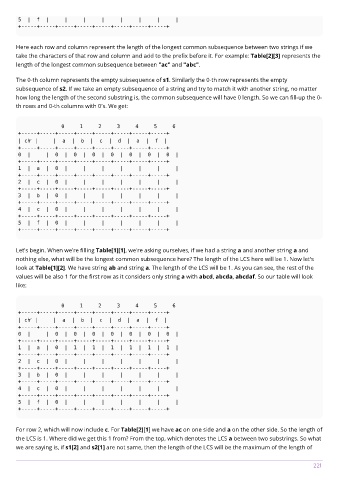Page 225 - Algorithms Notes for Professionals
P. 225
5 | f | | | | | | | |
+-----+-----+-----+-----+-----+-----+-----+-----+
Here each row and column represent the length of the longest common subsequence between two strings if we
take the characters of that row and column and add to the prefix before it. For example: Table[2][3] represents the
length of the longest common subsequence between "ac" and "abc".
The 0-th column represents the empty subsequence of s1. Similarly the 0-th row represents the empty
subsequence of s2. If we take an empty subsequence of a string and try to match it with another string, no matter
how long the length of the second substring is, the common subsequence will have 0 length. So we can fill-up the 0-
th rows and 0-th columns with 0's. We get:
0 1 2 3 4 5 6
+-----+-----+-----+-----+-----+-----+-----+-----+
| chʳ | | a | b | c | d | a | f |
+-----+-----+-----+-----+-----+-----+-----+-----+
0 | | 0 | 0 | 0 | 0 | 0 | 0 | 0 |
+-----+-----+-----+-----+-----+-----+-----+-----+
1 | a | 0 | | | | | | |
+-----+-----+-----+-----+-----+-----+-----+-----+
2 | c | 0 | | | | | | |
+-----+-----+-----+-----+-----+-----+-----+-----+
3 | b | 0 | | | | | | |
+-----+-----+-----+-----+-----+-----+-----+-----+
4 | c | 0 | | | | | | |
+-----+-----+-----+-----+-----+-----+-----+-----+
5 | f | 0 | | | | | | |
+-----+-----+-----+-----+-----+-----+-----+-----+
Let's begin. When we're filling Table[1][1], we're asking ourselves, if we had a string a and another string a and
nothing else, what will be the longest common subsequence here? The length of the LCS here will be 1. Now let's
look at Table[1][2]. We have string ab and string a. The length of the LCS will be 1. As you can see, the rest of the
values will be also 1 for the first row as it considers only string a with abcd, abcda, abcdaf. So our table will look
like:
0 1 2 3 4 5 6
+-----+-----+-----+-----+-----+-----+-----+-----+
| chʳ | | a | b | c | d | a | f |
+-----+-----+-----+-----+-----+-----+-----+-----+
0 | | 0 | 0 | 0 | 0 | 0 | 0 | 0 |
+-----+-----+-----+-----+-----+-----+-----+-----+
1 | a | 0 | 1 | 1 | 1 | 1 | 1 | 1 |
+-----+-----+-----+-----+-----+-----+-----+-----+
2 | c | 0 | | | | | | |
+-----+-----+-----+-----+-----+-----+-----+-----+
3 | b | 0 | | | | | | |
+-----+-----+-----+-----+-----+-----+-----+-----+
4 | c | 0 | | | | | | |
+-----+-----+-----+-----+-----+-----+-----+-----+
5 | f | 0 | | | | | | |
+-----+-----+-----+-----+-----+-----+-----+-----+
For row 2, which will now include c. For Table[2][1] we have ac on one side and a on the other side. So the length of
the LCS is 1. Where did we get this 1 from? From the top, which denotes the LCS a between two substrings. So what
we are saying is, if s1[2] and s2[1] are not same, then the length of the LCS will be the maximum of the length of
colegiohispanomexicano.net – Algorithms Notes 221

